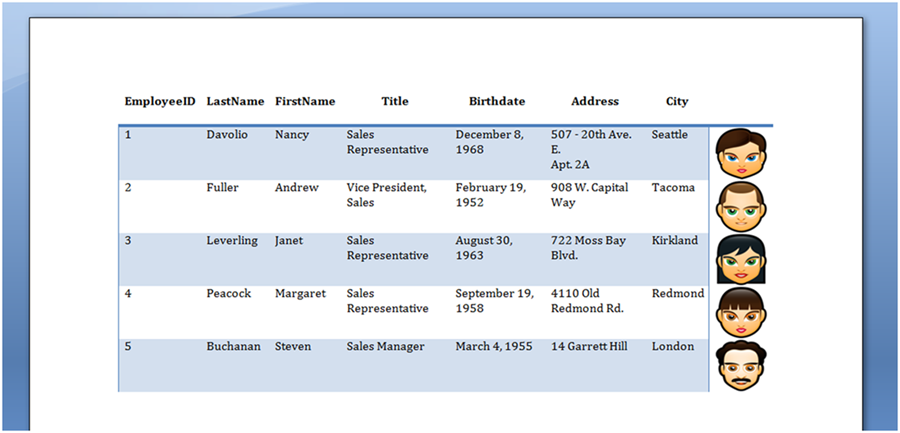Создайте таблицу из DataTable
Часто ваше приложение извлекает данные из базы данных и сохраняет их в виде DataTable. Возможно, вы захотите легко вставить эти данные в свой документ в виде новой таблицы и быстро применить форматирование ко всей таблице.
Обратите внимание, что предпочтительным способом вставки данных из
DataTable в таблицу документа является использование
Mail Merge с областями Метод, представленный в этой статье, рекомендуется только в том случае, если вы не можете заранее создать подходящий шаблон для объединения данных, другими словами, если вам требуется, чтобы все происходило программно.
Используя Aspose.Words, вы можете легко извлекать данные из базы данных и сохранять их в виде таблицы:
- Создайте новый объект DocumentBuilder на вашем Document.
- Начните новую таблицу с помощью DocumentBuilder.
- Если мы хотим вставить имена каждого из столбцов из нашего DataTable в качестве строки заголовка, то выполните итерацию по каждому столбцу данных и запишите имена столбцов в строку таблицы.
- Выполните итерацию по каждому DataRow в DataTable:
- Выполните итерацию по каждому объекту в поле DataRow.
- Вставьте объект в документ, используя DocumentBuilder. Используемый метод зависит от типа вставляемого объекта, например, DocumentBuilder.writeln() для текста и DocumentBuilder.insertImage() для массива байт, представляющего изображение.
- В конце обработки строки данных также завершите строку, создаваемую с помощью DocumentBuilder, используя DocumentBuilder.endRow().
- Как только все строки из DataTable будут обработаны, завершите работу с таблицей, вызвав DocumentBuilder.endTable().
- Наконец, мы можем задать желаемый стиль таблицы, используя одно из соответствующих свойств таблицы, например Table.getStyleIdentifier(), чтобы автоматически применить форматирование ко всей таблице.
В этом примере используются следующие данные в нашем DataTable:

В следующем примере кода показано, как выполнить описанный выше алгоритм в Aspose.Words:
Затем метод можно легко вызвать, используя ваши DocumentBuilder и данные.
В следующем примере кода показано, как импортировать данные из DataTable и вставить их в новую таблицу в документе:
Таблица, показанная на рисунке ниже, создается путем выполнения приведенного выше кода.


